
“Every system is perfectly designed to get the results it gets.”—Paul Batalden, Medical Expert
In his book, Upstream: How to solve problems before they happen, Dan Heath talks about how upstream decisions can have a greater impact on downstream results. He also explains the difference between upstream decisions and preventative measures (being proactive is not the same as thinking upstream).
Upstream decisions require a deeper level of thinking to find an appropriate solution rather than being responsive with preventative measures. For example, a life preserver is a preventative measure (downstream thinking), while investing in swimming lessons is an upstream decision.
And that’s why I’m writing today.
I will provide practical advice on how to think upstream to boost your performance and see more consistent progress with your training before it even starts. I will also explain the higher-level tactics and “invisible” aspects of strength training.
How It Began
When I started using kettlebells (circa 2006), there were only a handful of guys speaking on the subject (this was before I found Pavel’s work). YouTube was just getting off the ground, which meant little to no content for a newbie trying to learn how to get in shape in minimum time to train Jiu-Jitsu more and get injured less.
The end result?
Me trying to figure everything out on my own.
(It didn’t turn out well, and I have the welts on my wrists to prove it.)
Today strength training with kettlebells has become mainstream, but here’s what no one is talking about:
The invisible aspects of strength training. The ones that are responsible for providing the results you’re not even aware of.
The reason for this is that upstream decisions are intangible, while downstream decisions are more measurable.
If you don’t know what you’re looking for, the downstream effects could bite you in the… well, you know where.
Since 2011, I’ve been teaching a series of “Upstream Strength Strategies” to private students at our gym, the Hardstyle Fitness Academy.
The results have been jaw-dropping.
We’ve seen deadlifts increase from as little as 30lb in eight weeks to 110lb in twelve months.
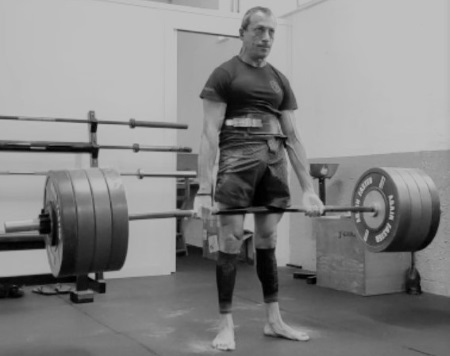
Keep in mind, these are busy moms and dads, just regular Joes and Janes like you and me.
I personally took a 475lb ten rep max (10RM) in the deadlift to a 505lb 10RM in four weeks lifting nothing heavier than 415lb.
Once you understand these “Upstream Strength Strategies” and know how to put them into a simple and repeatable plan of action you will:
- Build a stronger, leaner, and more resilient body in less time.
- Increase your muscle-building potential with fewer moving parts in your training.
- Follow a repeatable framework to customize your weekly training according to your schedule and lifestyle.
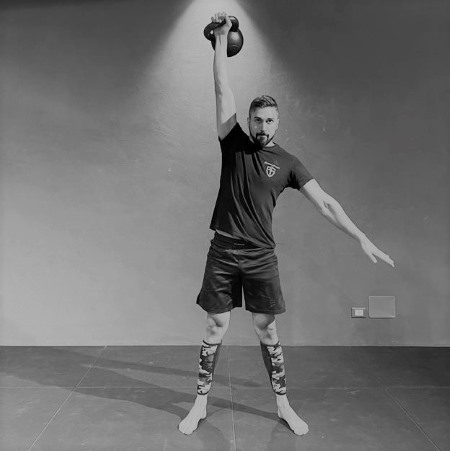
Five Upstream Strength Strategies to Boost Performance before Training Starts
At the Hardstyle Fitness Academy, we follow two philosophies:
- Philosophy #1: The “Strength Engine” (SE)
- Philosophy #2: The “Power Engine” (PE)
Think of the “Strength Engine” as having a three-part filter.
Before I take any of our students (or myself) through a training program, it needs to pass the following:
- It follows a less is more approach.
- It has only a few moving parts.
- It is highly accessible.
Our students’ training needs to be simple.
Simplicity = Repeatability for everyday Joes and Janes.
Repeatability = Consistency.
Consistency = Long term progress.
Remember, “every system is perfectly designed to get the results it gets.”
If you want repeatable and consistent results, training needs to be simple—especially as life becomes more complex and stressful.
I use the following five strategies to ensure our programs pass the three filters listed above. They are minimalism (and simplicity) at its finest—the 20{32c02201c4e0b91ecf15bfd3deecd875caca8b9615db42cfd45ce3d8de8d0829} that delivers 80{32c02201c4e0b91ecf15bfd3deecd875caca8b9615db42cfd45ce3d8de8d0829} of your results.
Upstream Strength Strategy #1: Concepts of Strength Training
Hindsight is 20/20.
If I had the option to start Jiu-Jitsu (and strength training with kettlebells) all over again, I would focus on understanding the concepts of strength training first.
The why behind the how.
For example, when you understand why you’re gripping a certain way, putting your feet here, and breathing this way, the how becomes easy.
Let’s look at gripping the kettlebell for a second.
Grip #1: The crush grip
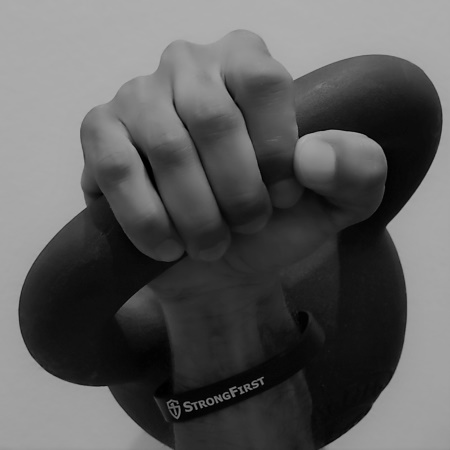
For many this is the appropriate grip for your “grind” exercise like the press, get-up, and front squat. It gives you more surface connection, allowing you to “crush” the handle to recruit more of the shoulder and lats for a stronger press.
Grip #2: The false grip
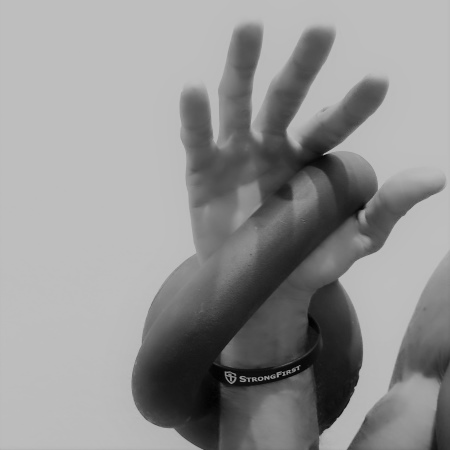
When it comes to higher volume ballistic exercises like cleans, snatches, push presses, and jerks the false grip is the money grip for two reasons:
- You can relax your grip during higher volume sets/sessions (your grip usually gives out before your legs do).
- The kettlebell rests on the heel of the palm which innervates a nerve to kick on your triceps giving you a faster lockout.
Grip #3: The hook grip
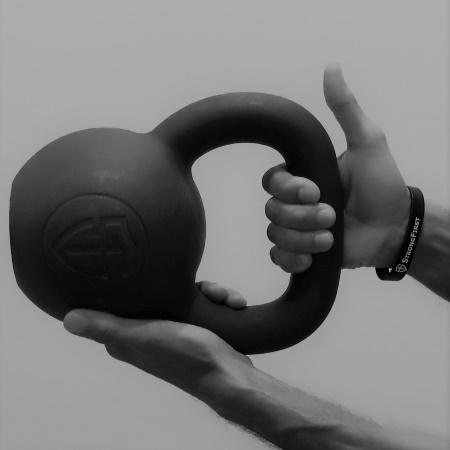
When I first started using kettlebells, I used to grab a kettlebell like a dumbbell—very similar to the “crush grip.” This is not an ideal grip when swinging, cleaning, and snatching a kettlebell.
To save your hands so you can get the most from your practice, you want to hook the kettlebell.
The beauty of strength training with kettlebells is that they are self-correcting. They let you know when something is off either in the form of bruised/swollen wrists or torn up hands.
This upstream awareness of the why leads to the second strategy.
Upstream Strength Strategy #2: Technical Skill (Practice versus Working Out)
Once you understand the concepts of strength training, you can put them into repeatable practice.
For years I just “worked out.” And for years, I remained the same. On the mat my grip was still failing, and I was still gassing out after a couple of rounds.
Why?
Because “every system is perfectly designed to get the results it gets.”
Random workouts and 10,000 kettlebell swing challenges are perfectly designed to get you random (unrepeatable) results.
Like Jiu-Jitsu, strength—an upstream concept—is a skill. And skills must be practiced.
Why practice versus working out?
Because practice is simple, repeatable, consistent.
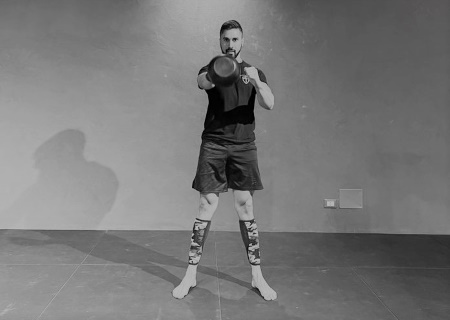
Upstream Strength Strategy #3: The Professional Application of Tension
Maximum tension is strong, but slow.
Speed, agility, quickness, and flexibility are fast and loose, but weak.
Knowing how much tension to apply to achieve a task is the nuance. In Jiu-Jitsu, knowing to get tight when trying to finish a pressure pass and when to be loose so you can lock in a submission is a skill.
As Brett Jones, StrongFirst Director of Education, would say, it’s about “lowering the volume, not changing the channel.”
Let’s look at a couple of examples:
- The get-up: A strong woman warming up the get-up with a 16kg kettlebell doesn’t need to generate a lot of tension or use power breathing. She needs just enough tension to make sure her shoulder is connected and she has a firm grip on the kettlebell. Her breathing should be “natural” with a standard biomechanical breath match on the lunge to standing. If I had to give the amount of required tension a number, I would say a 5 out of 10 effort.
Compare this to a woman performing a half bodyweight get-up. In this case, tension would be near maximum. She would crush grip the kettlebell and power breathe at multiple stages. The get-up would be slower because near maximum tension is strong, but slow.
- The Military Press: A gentleman pressing 50{32c02201c4e0b91ecf15bfd3deecd875caca8b9615db42cfd45ce3d8de8d0829} of his 1RM does not need to generate a lot of tension.
However, the tension required for him to press half his bodyweight would be much different. You get the idea.
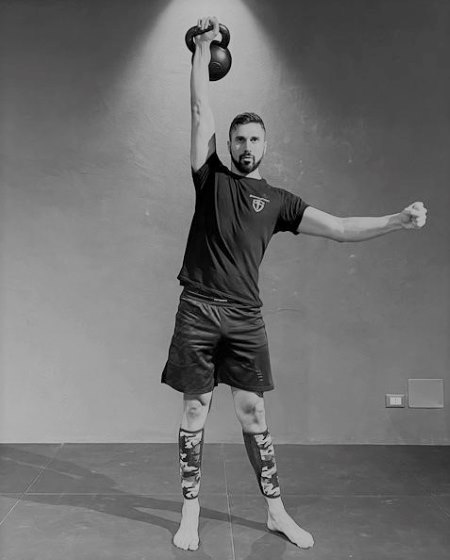
Similar to Strategy #1, it is essential to know why you’re applying tension because if/when tension becomes the sole focus of your practice, you could jeopardize your efforts all together.
This leads us to the next strategy.
Upstream Strength Strategy #4: Dominanta Plus the Quantum Zeno Effect
“What fires together, wires together.”—Hebb’s Law.
Once you understand why and when to be tight, it is all about focus.
In his book, You Are Not Your Brain, Neuroscientist, Dr. Jeffrey Schwartz refers to a phenomenon known as the “Quantum Zeno Effect” (QZE).
It complements Hebb’s law, describing how keeping your muscles firing together long enough —through focused attention—creates an entirely new brain circuit.
This is where habits come from.
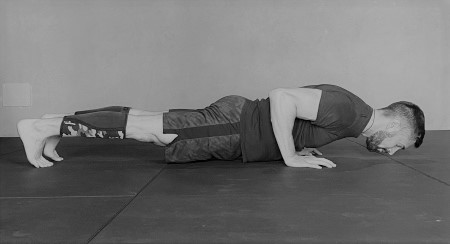
The better you become at synchronizing your muscles, the stronger you’ll be. And the better you’ll be at pressing, deadlifting, and training Jiu-Jitsu.
This is why “strength is a skill.”
The QZE is essentially your ability to focus.
In the StrongFirst system, we call this “Dominanta”—the “Dominant Thought.”
When building a heavy press, shift your focus to the muscles that need to fire so they can wire together.
Don’t focus on how hard the press is. Don’t focus on how heavy the weight is.
Focus on your breath. Focus on applying the right amount of tension. Focus on visualizing the end of the lift.
When you can sync your muscles efficiently, deploy the “professional application of tension,” and maintain Dominanta, you solidify the creation of new brain circuits.
This makes strength automatic and consequently boosts performance before the lift even happens.
Upstream Strength Strategy #5: Posture Plus Positioning = Maximum Leverage
“Position before submission.”—Aurelio Gallegos Jr, 4th Degree BJJ Black Belt.
This was one of the first things I learned from Aurelio—my first Jiu-Jitsu coach. Before you can execute a submission, you must first have a strong position. And before you can get into a strong position, you need a strong posture.
Strong Posture = Strong Positioning = Maximum Leverage.
To be effective on the mat and get the most from your strength training efforts, posture and positioning are non-negotiables.
From December 2021 through March 2022, I deadlifted a barbell for 85 straight days. You can read about this in my article, “How to Deadlift a Barbell Every Day.”
In addition to each session, I performed a “technical day” once a week. This is where I focused on applying all five strategies.
I would set a timer for 30-45 minutes and focus on honing my deadlift skill. Particularly the wedge and getting the weights to “break” off the floor before the lift even occurred.
The wedge is a prime example of upstream strength training.
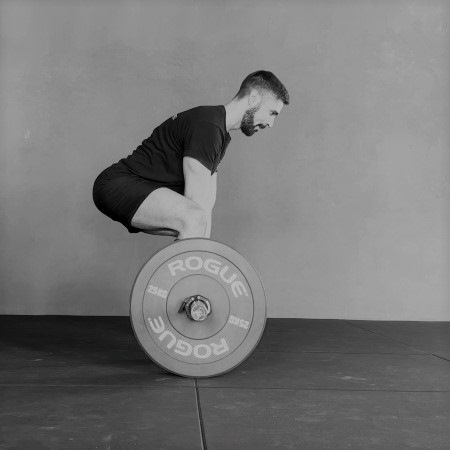
It requires regular practice, the proper application of tension, unwavering focus, and builds your posture so you can get in the right position for maximum leverage and a stronger pull.
The downstream effects after 85 days?
Day 30: +50lb to my training max.
Day 66: +40 b to my training max.
Day 85: 575lb for a triple.
All without over training or interfering with my duties as a husband and father.
Learn How to Apply the “Upstream Strength Strategies”
If you’re not seeing the progress you envisioned when you started using kettlebells (or strength training as a whole), I’m willing to bet you’re not taking a less is more approach in your training by thinking downstream instead of upstream.
Once you understand the following:
- Concepts of Strength Training.
- Technical Skill: Practice versus Working Out.
- Professional Application of Tension.
- Dominanta plus the Quantum Zeno Effect.
- Posture plus Positioning for Maximum Leverage.
The results will take care of themselves because “every system is perfectly designed to get the results it gets.”
I’ll be teaching these “Upstream Strength Strategies” (and a few others) at Programming Demystified—including more on Philosophy #2: The Power Engine and its three parts:
- The “Power 4”
- Pattern Pairing Progressions
- Practice Tactical Method
And how they will help you to:
- Build your own kettlebell complex programs.
- Put together a strategy for strength, strength-endurance, hypertrophy, maximal strength, and power training (another upstream strategy).
- Design a framework to build customizable (and scalable) training plans.
I’ll also be giving away three of our most successful plug-n-play training plans based on real world experience using the “Upstream Strength Strategies:”
- ‘Mat Strong!’ Protocol
- ‘Always Be Ready!’
- Strength Plan 701A
See you at Programming Demystified.
Programming Demystified, the new StrongFirst Seminar with
Pavel Tsatsouline, Fabio Zonin, Hector Gutierrez Jr.








